“Kid, the next time I say, ‘Let’s go someplace like Bolivia,’ let’s GO someplace like Bolivia.”
– Paul Newman, in the movie Butch Cassidy and the Sundance Kid
While we know them best as Butch and Sundance, their original names were Robert LeRoy Parker and Harry Alonzo Longabaugh. There’s a fairly good record of their lives, which involved the entire bank and train robbery history, along with a vague attempt to disappear from that life by becoming farmers here in Argentina, down in Patagonia, only to find themselves back in it for “one more job”, leading to the infamous shootout in Tupiza, Bolivia, against a couple of soldiers, town police and the mayor. Then again, the latter has never been proved conclusively, and there’s some conjecture that a couple of other banditos were setup to take their place, while Butch and Sundance quietly returned to Utah and took up lives under another set of assumed names. Either way, the incident was enough to spark some Casa SaltShaker interest 101 years later, and a chance to play around with some Bolivian cuisine.
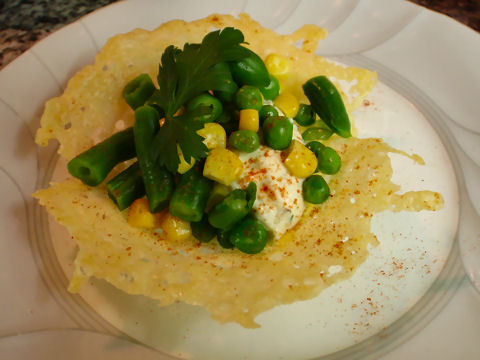
There is a plate of daily fare in the city and surrounding area of La Paz, called, simply, a plato paceño. At the most fundamental, it consists, generally, of a slab of simple white cheese, generally fried, a boiled potato, a piece of an ear of corn, and some peas and/or green beans. Maybe a piece of meat, but not necessarily. It’s filling, relatively nutritious, and cheap. It was also an inspiration to turn the whole thing inside out and create these little parmesan baskets filled with goat cheese mousse flavored with thyme and parsley, and top it with some fresh corn, peas, green beans and a touch of finely diced red rocoto peppers (first day, mixed into the mousse, second day, sprinkled atop for more color) – the whole think dusted with some hot paprika.
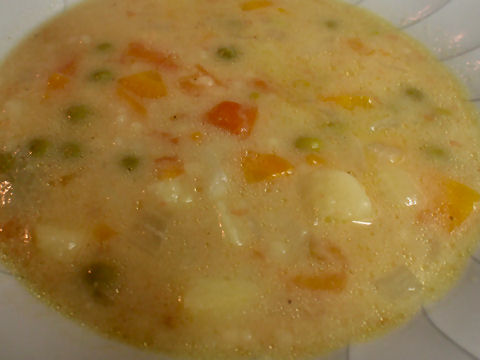
Arguably, the best known soup of the Bolivian canon of dishes is the sopa de maní, or peanut soup. Having recently produced a West African version to a bit of acclaim, taking this one on seemed a logical choice. Strong beef stock, then a mix of onions, carrots, peas, tomatoes, potatoes and a good dollop of peanut butter gave the base, and then on the side, we served up dishes of salsa llajwa, the classic Bolivian hot sauce – puree of tomatoes, rocotos, shallots, huacatay, quirquiña, olive oil, salt and pepper (different preparation from the attempt on the link, much fresher tasting).
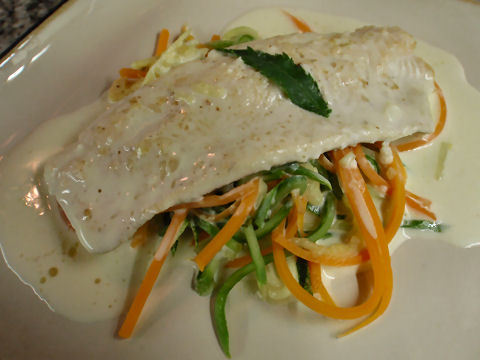
One of the favorites, especially around the Lake Titicaca area, is trucha a la crema – pretty much a fillet of trout boiled to death in cream, with little in the way of seasoning. Here, I marinated the trout for a couple of hours in a little lemon juice, sesame oil, ginger, chilies, salt and pepper, then baked it in the oven until just set. The sauce, a mix of cream and milk with a good amount of garlic in it, some more of the huacatay, salt and white pepper, all blended together and simmered until the flavors mellowed, then thickened with just a touch of cornstarch. Served over blanched, julienned zucchini and carrots tossed with a little butter and salt.
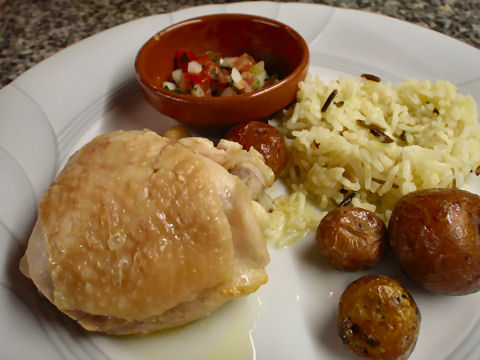
Pretty much the traditional dish here, picante de pollo – chicken thighs braised slowly in stock with onion, tomato, rocoto, cayenne, parsley, cumin, oregano, garlic, salt and pepper. Served with a mix of basmati and wild rice, small Andean potatoes that were first boiled and then tossed with hot butter for a few minutes, and a salsa cruda of onion, tomato, rocoto, parsley, salt and pepper.
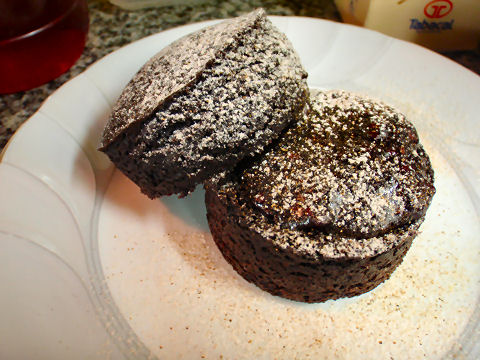
And, finally, a little cake based on a common penchant in Bolivia for chocolate and cinnamon together – or at least so a couple of sources claimed. I whipped up a batch of the chocolate-chili cupcakes that have been so popular in various guises, split them open and spooned on some hot blackberry jam, then dusted the whole thing with cinnamon and sugar.
I vote for the quiet lives in Utah after having successfully scooted away….
I have to say that visually, at least, Bolivian food seems very strange and not overly appealing, Those cupcakes, on the other hand, look great. What’s the recipe?
Well, there are some who do find that for the most part, Bolivian food seems like a twin of some sort to the rest of the food of the altiplano – the Peruvian side around Puno and such, and it does seem that they may be the case in modern day. Keeping in mind that while Bolivia has a huge wealth of natural resources, it has, economically, gone from being one of the wealthiest parts of the Incan and later Spanish empires, to the poorest country in South America (based on GDP), with some 2/3 of the population living in poverty. No doubt that has had an impact over time on the food that is currently available and offered up as the national cuisine versus what it likely was at one time. Overall, this exercise in taking the modern day offerings and turning them into something more interesting for our table was quite interesting – rivalling, in some ways, our recent World Food Day fare.
In terms of the cake, the recipe is linked in the posting….
[…] have made peanut soups before, in West African, Bolivian, and Thai guises. I have even once, before, more than six years before, made a quinua and peanut […]